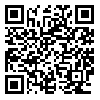BibTeX | RIS | EndNote | Medlars | ProCite | Reference Manager | RefWorks
Send citation to:
URL: http://rjms.iums.ac.ir/article-1-788-en.html

 , A. Akhavan Sepehi,
, A. Akhavan Sepehi, 
 , A. Mehrvar,
, A. Mehrvar, 
 , M. Azimi Rad,
, M. Azimi Rad, 
 , R. Edalat,
, R. Edalat, 
 , F. Jaffari
, F. Jaffari 
 , M. Sanaee,
, M. Sanaee, 
 , K. Mirsaeedi,
, K. Mirsaeedi, 
 , M.R. Zali,
, M.R. Zali, 

Background & Aim: Salmonella is the most important pathogenic microorganism causing food borne disease and diarrhea in humans. It could present as diarrhea, fever, vomiting and sometimes bloody diarrhea. Because of its' importance as one of the pathogens, it is essential to identify and characterize its serotypes by molecular methods. The aim of this study was to characterize PCR-Ribotyping technique for identification of salmonella serotypes in stool samples. Material and Methods: In this study our samples were salmonella strains isolated from 115 stools of children with diarrhea. After serotyping, their DNA was extracted with phenol/chloroform method. We performed the PCR-Ribotyping method with P1, P2 primers for 16S-23SrRNA gene. Finally PCR-products were electrophoresed on 1.8% agarose gel. After Ethidium Bromide staining we analysed it. Data were analyzed by SPSS 11.5, Chi-Square test and NTSYS2. Results: One hundred and fifteen strains contained paratyphi A, B, C, D and serotype typhi. All of the serotypes had similar 5 bands ranging 700 to 2500bp. Conclusion: According to the results we conclude that PCR-Ribotyping method has the highest sensitivity for identification of genus salmonella but it does not have enough power to discriminate between various salmonella serotypes.



